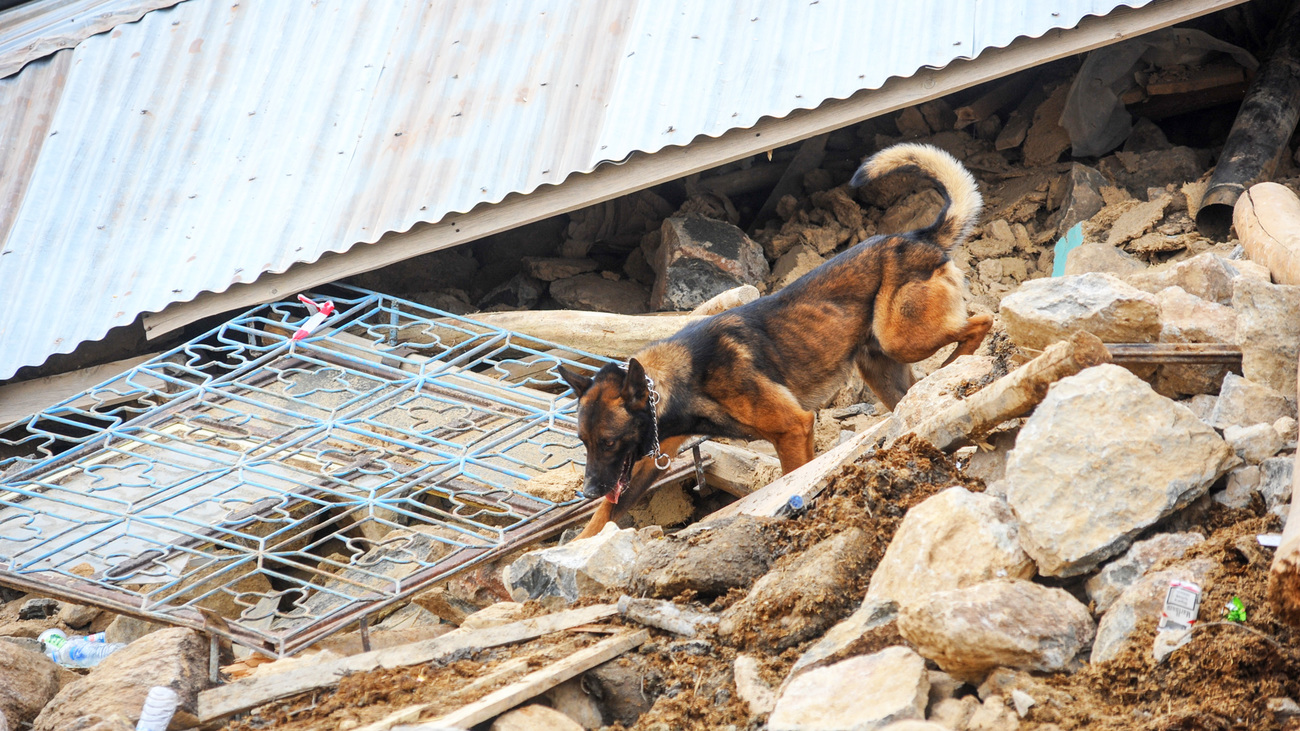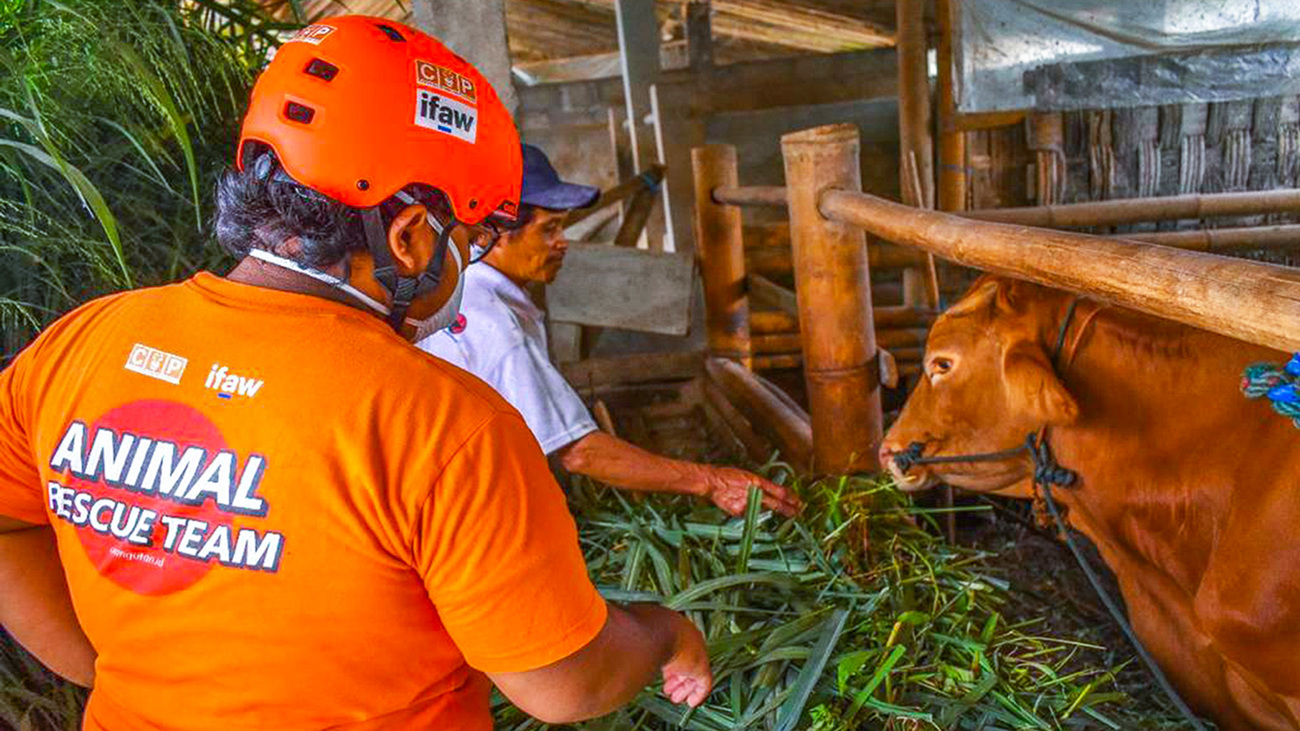How disasters impact animals
How disasters impact animals
Disasters impact the lives of animals in many different ways, from causing injuries and fatalities to degrading their habitats and forcing them into closer proximity with humans. While many disasters are unpredictable, humans have the ability to prepare ourselves—and animals—so we’re ready when disaster strikes. We can also work to respond to these disasters and rescue animals that are injured, sick, or stranded.

IFAW is a rescue and conservation organisation. Much of our work involves responding to disasters around the world, aiding local rescue efforts in the midst of floods, fires, earthquakes, and other disasters that impact wildlife. We know first-hand the devastating effects such events can have on communities and animals—and the importance of being prepared for them.
What happens to animals during earthquakes?
Earthquakes can be devastating for animals. They may trigger tsunamis and landslides, which can damage habitats as well as cause injury and death. Animals living in human-populated areas may also be buried under rubble from collapsed buildings.
Earthquakes can even impact animals that don’t live on land, such as whales. Because earthquakes produce some of the loudest underwater sounds on the planet, whales may experience hearing damage, displacement, and changes in behavior. This poses a threat as whales rely on underwater sound for communication, detecting prey, and navigation.
What happens to animals during wildfires?
Though many animals can take cover under rocks or bury themselves in the dirt, many others cannot outrun wildfires.
Fires have a significant impact on wildlife. Even if they survive smoke inhalation and burns, habitat loss threatens animals in areas affected by wildfires. While fleeing a fire, animals are also exposed to other dangers, such as collisions with vehicles. They may face conflict with humans if they end up in densely populated areas.
In 2023, wildfires raged through Greece, devastating countless people and animals. Many animals became trapped and burned, and biodiversity loss was a major concern. The fires burned nearly 50,000 hectares (500 square kilometres) of forest and vegetation, decimating wild habitats. In addition, in just one month, the fires emitted 3.5 million tonnes of CO2.
The same year, wildfires in Maui wreaked havoc on local wildlife, displaced people from their homes, and separated many families from their domestic animals. Maui is also home to a large number of endangered species, particularly its forest bird species.

How are animals impacted by storms?
Called hurricanes in the Atlantic and typhoons in the Pacific, tropical cyclones, while usually forecasted, can be difficult to prepare for.
Flooding is the most common disaster in the world. Heavy rains and compromised drainage and can leave animals stranded, in danger of drowning, or separated from their human or animal families. Young wildlife may become orphaned, which impacts their chances of survival.
In fall 2024, back-to-back hurricanes Helene and Milton roared through the Caribbean, Mexico, and the US. As people evacuated, many animals became separated from their families, so animal shelters began to took on dozens of new rescues.
Rains and strong winds can also severely damage or destroy buildings, which includes animal shelters. In October 2024, the rainy season in Nepal and Thailand caused extreme flooding and landslides, directly impacting hundreds of thousands of people and killing more than 200. Two shelters in Nepal that suffered considerable damage were Alina’s Animals Preservation Nepal and Voice for Animals Nepal, both of which IFAW is supporting in their repair efforts. We also supported three organisations in Thailand impacted by the floods: New Hope for Animals, Hand to Paw, and Elephant Nature Park. These rebuilding efforts will help make these shelters more resilient to disasters in the future.
Severe storms can also cause habitat loss for wildlife. Uprooted trees pose a clear threat to species that live in them, like many birds, and trees and shrubs also become stripped of the food sources they provide for some animals. In February 2022, Storm Eunice caused wind gusts up to 196 kilometres per hour (122 miles per hour) and impacted the UK, the Netherlands, Belgium, France, Denmark, and Poland.
In the wake of severe rainfall in May 2024, both domestic and wild animals in southern Brazil were impacted. Domestic animals were separated from their owners, and wild animals became displaced from their habitats due to sudden landslides and floods.
As storms are increasing in frequency, unpredictability, and intensity, it becomes more difficult to prepare shelter, animal food, and veterinary services.
How do volcanic eruptions impact animals?
Animals can be killed by lava flows, pyroclastic flows, tephra falls (falling rock), atmospheric effects, and gases. Volcanic eruptions can also trigger earthquakes and wildfires, which can kill animals and destroy the habitats of survivors. Eruptions themselves can destroy plant life, on which many animals may rely for food or shelter. Famine as a result of eruptions can cause more fatalities.
As an example of how devastating a volcanic eruption can be for an ecosystem, the eruption of an underwater volcano in Tonga released gases that create acid rain, which can harm the environment as well as agriculture. A blanket of ash coating the sea floor has buried many deep-ocean organisms, decimating their populations.
Following the 2023 eruption of Mount Merapi in Indonesia, local communities struggled to find fresh grass for their farm animals, as most of the ground became covered in ash. IFAW continues to work with this community on disaster preparedness, animal rescue training, and supporting rehabilitation efforts, including at the Centre for Orangutan Protection.
Volcanic eruptions can also impact aquatic animals, as they can cause an increase in acidity and turbidity as well as water temperature changes. These effects can kill smaller aquatic animals that are the prey of larger animals, cutting off their food supply.

How does human conflict impact animals?
War and other human conflicts unfortunately spill over into the natural world, impacting landscapes and wildlife. Conflicts also affect pets and other animals in captivity.
According to research that analysed decades of wildlife population trends in Africa, the most important predictor of whether a species will flourish or perish is the presence of human conflict. The use of chemicals and landmines can have devastating impacts on habitats and kill animals directly. Conflict can also cause an increase in unsustainable hunting and poaching, both for food and to raise funds. This is heightened by an increased availability of small arms. Naval exercises impact marine animals and have been known to cause mass strandings of whales and dolphins.
Food shortages caused by conflict also result in farm and companion animals being euthanised because owners could no longer feed them. During many conflicts, companion animals are also abandoned or become lost when people are displaced from their homes.
Throughout ongoing war in Ukraine, hundreds of thousands of animals—pets, farm animals, captive animals, and wildlife—have been in need. Many refugees escaping to neighboring countries brought their companion animals with them, but others have been found abandoned. A large number of wild animals needed rescue and evacuation, having been abandoned in backyards by private owners or having had their habitat impacted by continued shelling and the placement of landmines.
In 2024, the escalation of conflict in the Democratic Republic of the Congo has displaced thousands of people and left many animals lost, abandoned, and stolen. This poses risks to both human and animal health, and many of these animals are vital to people’s livelihoods.
How can we help animals in disasters?
There are many ways we can help animals affected by earthquakes, wildfires, storms, and other disasters. For one, we can make sure our own pets, farm animals, and companion animals are prepared for any disaster to strike. Check out IFAW’s #DisasterReady resources to learn more.
Second, we can work to mitigate the effects disasters may have by building resilience within communities and landscapes. IFAW works with local governments, organizations, and communities to ensure that both humans and animals have a path to safety. We also train responders in every aspect of disaster preparedness and technical response, including search and rescue, temporary sheltering, and emergency veterinary care.
IFAW has also founded and committed to various animal rescue networks, consisting of thousands of strategically located partners, experts, and authorities across the globe to help respond immediately when disaster strikes.
Learn more about how we prepare animals and communities for disaster.
Related content
Our work can’t get done without you. Please give what you can to help animals thrive.